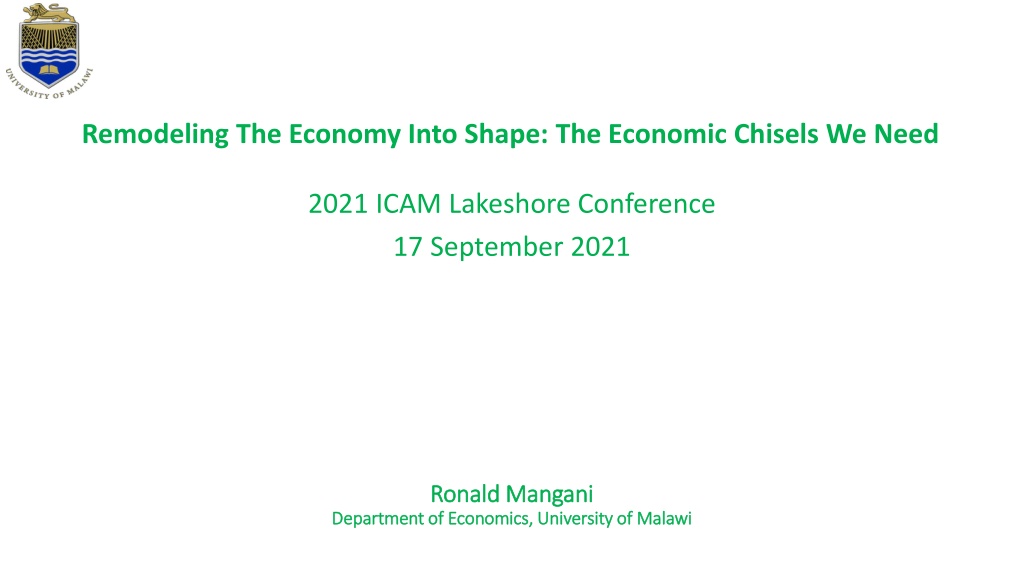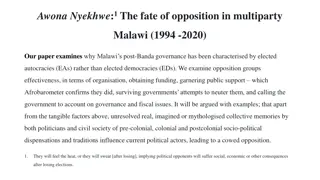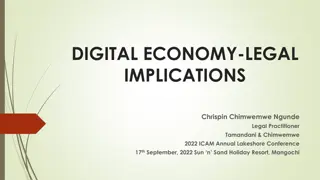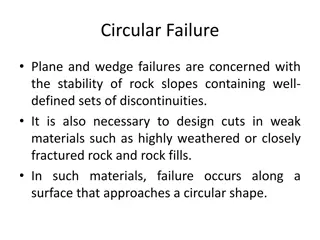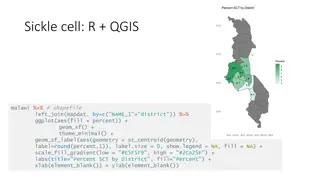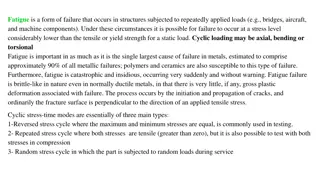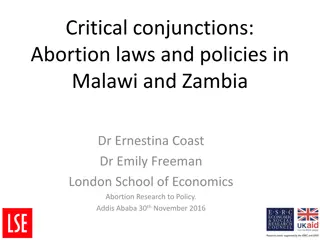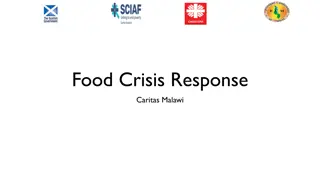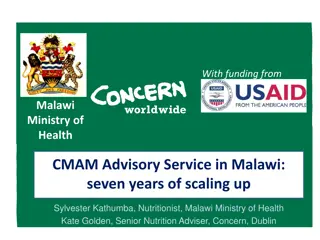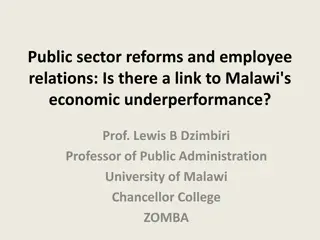Remodeling the Economy into Shape: Addressing Fragility and Failure Challenges in Malawi
Malawi faces challenges of fragility and failure in its economy, necessitating urgent economic transformation and industrialization. The country's poor economic performance and vulnerability to external factors highlight the need for government intervention and tough decision-making. The country is currently among the 50 most fragile nations, with demographic pressures and weak public services contributing to its risks. The impact of COVID-19 compounds these challenges, making it imperative for Malawi to take proactive steps towards sustainable economic development.
- Malawi economy
- fragility challenges
- economic transformation
- industrialization
- government intervention
Download Presentation

Please find below an Image/Link to download the presentation.
The content on the website is provided AS IS for your information and personal use only. It may not be sold, licensed, or shared on other websites without obtaining consent from the author. Download presentation by click this link. If you encounter any issues during the download, it is possible that the publisher has removed the file from their server.
E N D
Presentation Transcript
Remodeling The Economy Into Shape: The Economic Chisels We Need 2021 ICAM Lakeshore Conference 17 September 2021 Ronald Mangani Ronald Mangani Department of Economics, University of Malawi Department of Economics, University of Malawi
Take-Aways 1. Malawi is trending towards fragility and failure And there is no self-correction mechanism in sight 2. There is no substitute for economic transformation and industrialization Only two options exist: transform and industrialise, or perish 3. Government Intervention Is Critical For Industrialisation In history, not a single country has industrialised otherwise 4. Tough decisions must be made sooner rather than later by Malawians On the role of the state On financing private sector investment and monetary policy On financing public sector investment (and consumption!) On trade and foreign exchange earnings On the attitude of a whole people
The problem is a lot of what is called economics is not economics. It is more ideology or religion. Joseph Stiglitz
Malawi: trending towards fragility and failure Malawi is getting poorer! 1964 - 1980 1981 - 2018 GDP growth (average % p.a.) 6.1 3.6 Per capita GDP growth (average % p.a.) 3.3 0.8 Source: WDI Poverty Has Deteriorated Between IHS3 (2011) & HIS 5 (2020) Growth has slowed down since 1981 Real GDP Growth (% p.a.)
Malawi: trending towards fragility and failure Malawi is getting poorer The World s Poorest Countries (By GDP/Capita, PPP) Rank 10 9 8 7 6 5 4 3 2 1 * https://www.worldatlas.com/articles/the-poorest-countries-in-the-world ** https://data.worldbank.org/indicator/NY.GDP.PCAP.PP.CD ***http://www.financialjesus.com/interesting-economics/top-10-poorest-countries-in-the-world-2010/# 2019* Chad Eritrea Liberia South Sudan Mozambique Niger Malawi D.R. Congo CAR Burundi 2015** Comoros Madagascar Eritrea Mozambique Malawi Niger Liberia DRC Burundi CAR 2010*** Afghanistan CAR Sierra Leone Eritrea Niger Somalia Burundi Liberia DRC Zimbabwe
Malawi: trending towards fragility and failure Malawi is among the 50 most fragile countries in the world Despite peace Demographic pressure is our biggest risk factor: 44 million people by 2050! Factionalised elites, weak economy and poor public services are huge pressure points We are also vulnerable to external intervention, and risk brain drain COVID-19 is but additive to a perpetual national crisis Fragile States Index: 2017 - 2021 and Brain Drain Public Services Refugees and Human Flight Demographic Factionalized Human Rights Intervention Economic Legitimacy Apparatus Grievance Inequality Pressures External Security Economy Total (Max =120) Group State Elites Rank (of 178) IDPs Year 2021 2020 2019 2018 2017 46 43 83.2 84 4.8 5.1 8.4 8.1 4.7 5 7.7 7.7 8 6.8 7.1 7.1 6.6 8.2 7.9 5.3 5.6 9.4 9.4 5.4 5.7 7.4 7.7 8.1 49 47 44 83.3 85.5 88 4.8 4.5 4.8 8.1 8.1 8.1 5.3 5.6 5.6 8 8.1 8 8.3 7.4 7.7 7.9 6.1 6.4 6.4 8 5.9 6.2 6.2 9.1 9.4 9.7 5.2 5.5 5.8 7.4 7.7 8.2 8.1 8.4 8.3 8.6 Average 46 84.8 4.8 8.2 5.2 8.0 8.1 7.4 6.5 8.2 5.8 9.4 5.5 7.7
The worsening trend of fragility and impoverishment will not correct itself The fault is not in our stars, but in ourselves. Cassius in Shakespeare s Julius Caesar
There Is No Substitute For Transformation Towards Industrialization Industrialisation equals development The fact that the term industrialised countries is used synonymously with developed countries implies that industrialization plays a major role in development and sustained economic diversification Alemayehu (2000) Development requires sustained economic growth Growth is a critical pathway out of poverty; critical for expanding education, health, nutrition & survival across populations (WEF, 2019) Effective and sustained growth requires economic transformation Requires the movement of excess labour from land (agriculture) to factories (Lewis, 1954; Singer, 1979; Dethier and Effenberger, 2011) Addresses declining land holdings: average farm size has shrunk by 50% since 1971 Options: Industrialise and transform, or perish!
There Is No Substitute For Transformation Towards Industrialization The road to transformation & industrialization rocket science (WEF, GCR, 2012) The sequencing is generally cast in stone!
Government Intervention Is Critical For Industrialisation it is a fallacy that early industrializers could have developed their industrial sector without infant industry protection The United States was the motherland of infant industry protection ., its (Great Britain s) industrial sector benefited from trade protection and other forms of government intervention in the trade flow through the Navigation Act and by means of political power and even military power even when the industrial sector was mature, protection was used as a means of bargaining power in bilateral trade negotiation and trade treaties Shafaeddin (1998) Government intervention in the USA, UK, Germany and France was used to: Influence the direction of trade Assist capital accumulation Develop institutions Build infrastructure Facilitate research and development initiatives
Government Intervention Is Critical For Industrialisation The Chinese model of industrialization suggests that political stability, trade openness and domestic market liberalization are critical for late-comers Labour-intensive production crucial in reducing poverty and achieving competitiveness Yet even the Chinese model is government-driven And we have witnessed a period of historic China-Western trade wars The Chinese model is not void of calculated protection Malawi, therefore, needs home-grown solutions to achieve rewarding industrialization
Malawis Industrial Performance: Regression to Mediocrity Malawi has been on that industrialisation road before!! By the 1960 -1992 trend, Industry should be contributing upwards of 60% to GDP! 120 Contribution to GDP (%) 1960 1990 2019 Industry 13.3% 39.2% 20.1% 100 Agriculture 48.4% 38.5% 25.5% 2017 Agriculture = 26.1%; Manufacturing = 9.4%; Services = 52.4% Services 38.3% 22.3% 80 54.4% 60 The privatisation effect! 40 20 0 1960 1961 1962 1963 1964 1965 1966 1967 1968 1969 1970 1971 1972 1973 1974 1975 1976 1977 1978 1979 1980 1981 1982 1983 1984 1985 1986 1987 1988 1989 1990 1991 1992 1993 1994 1995 1996 1997 1998 1999 2000 2001 2002 2003 2004 2005 2006 2007 2008 2009 2010 2011 2012 2013 2014 2015 2016 2017 2018 2019 Industry (including construction) Agriculture, forestry & fishing Services
Industrys Contribution To Employment Is Insignificant & Declining Contribution to employment (2019) Agriculture = 72% Services = 20% Industry = 8% Trade liberalisation killed local industries and jobs. The loss of market-share by local products forced many local-firms to close down. Tens of thousands of jobs evaporated. The government watched helplessly as the economy nose-dived and big employers like BAT, Unilever, clothing-factories, Band C and PEW closed down, manufacturing operations or went belly-up. It became cheaper and more profitable to import finished-products than to make them here scaled-down their Tom Sangala (2015)
Government has failed to get the basics sustainably right Factor-driven economy: primary attention Should be to get these basics right Institutions, infrastructure, the macro-economy, basic health services, basic education Institutions to protect the interests of powerful road transporters, Malawi brings fuel at high cost from the sea bail can dubiously be granted to the convict of attempted murder Factionized elites render Malawi fragile (Average Fragile States Index = 8.2 of 10) Infrastructure Malawi ranks 171 of 190 countries on getting electricity in the DBI 2020 The macro-economy Gross official reserves only at 1.6 months of imports by end June 2021 (2 months by end June 2020) The exchange rate moved from K730/$ in January 2019 to K813/$ in August 2021 The maximum lending rate is 23.4% against a reference rate of 12% Education and health (human resource development) Primary school completion rate is only 51.2; secondary school is 22.1 In 2013, Malawi had the 2nd lowest reading and mathematics scores among standard 6 pupils in SADC Poor public services render Malawi fragile (Average Fragile States Index = 8.2 of 10)
Tough Decisions Must Be Made What should be the role of the State in Production? 1964 1980s: significant state role; extraction The triad s commercial holdings, mid-1980s: ADMARC = 34; MDC = 27; Press = 40+ (Chirwa, 2000) 77 commercial SOEs or semi-SOEs, rose to 121 by 1992 (Magalasi, 2008; World Bank, 1994) 1984 2002: Privatization of government assets; SOEs Initially parastatal reforms, asset swaps, divestitures and disposal Privatisation Act (1996) 53 SOEs privatized by 2002 Government struggles to meet commitments with the private sector; arrears 2011 date: The private sector can t do it alone, after all! Privatisation Commission becomes PPPC in 2011: regression to mediocrity! Government risks huge challenges to meet future commitments with the private sector Government intervention is critical for industrialisation and transformation The privatization agenda is a miserable flop only transferred assets into private hands for a song! Extraction (rent-seeking) is the thing to address through a system of sanctions and rewards
Tough Decisions Must Be Made How should Malawi finance public sector investment? Malawi is a signatory of the SADC Industrialisation Strategy and Roadmap (2015 2063) To double regional share of manufacturing from 15% to 30% by 2030, and to 40% by 2050 To increase regional share of manufactured exports from 20% of total exports to 50% by 2030 To increase the share of industrial employment to 40% of total employment by 2030 Malawi stands to profit from walking the talk on a SADC commitment Achieving industrialization and transformation faces resource constraint Financing gap in Malawi was estimated at 19.3% of GDP in 2014 Annual total financing requirement estimated at 25.6% of GDP tax revenue has averaged 13.1% of GDP p.a. during 1970/71 2019/20 From 17% to 11% after GDP rebasing; below SADC average of 25.9%; looming trouble for the tax-payer It is currently not feasible for the economy to realise this level of financing, and every day that passes without duly addressing economic growth concerns is costly and disastrous
Tough Decisions Must Be Made How should Malawi finance public sector investment? Criticism against deficit-budgeting by orthodox economists is dangerous and damaging Capital account deficit is a necessary stimulant with idle resources (Keynes, 1936; Lerner, 1943) Austerity poses a worrisome limitation on the government s ability to pursue public purpose (Armstrong, 2019) There is nothing characteristically bad about government borrowing; macroeconomic policies must reflect pragmatism rather than consistency with some traditional doctrine; and excessive aversion to public debt may lead to bad policies Armstrong (2019) Austerity usually killed formal-sector jobs, depressed economies effective demand, led to massive disinvestments in weak manufacturing sectors, and rewarded the financial sector more than the real, fiscal and external sectors of the domestic economy social inequality ultimately worsened. Because the ardently alleged crowdingout of private investment by government spending was not truly responsible for the low level of investment, the budget cuts did not spearhead private sector growth What is wrong with us is that we borrow for consumption, do not rationalize expenditures, and steal! Watkins (1995); Mangani, 2021)
Tough Decisions Must Be Made How should Malawi finance private sector investment? What should be the stance of monetary policy? what is the stance and real value of macro stability ? Private sector credit did not improve significantly in 2020 Credit to government increased by K85.0 billion to K1.1 trillion Credit to private sector increased by K25.6 billion to K638.2 billion Reserve Bank of Malawi, 2020
Tough Decisions Must Be Made How should Malawi finance private sector investment? What should be the stance of monetary policy? what is the stance and real value of macro stability ? Malawi must transform from a regime overly preoccupied with growth-dampening macroeconomic stability into one that is growth-focused and export-oriented Would grow a competitive industrial sector Would build adequate reserves necessary for achieving stability on the foreign exchange market Requires more than a referee central bank; more that moral suasion
Tough Decisions Must Be Made How should Malawi address the forex challenge? My Dos Do graduate from tobacco Should have seen the signals since WHO FCTC (2003) Buyer s market: Prices declining, mean-reverting Even Philip Morris says no, hence FFSFW Buyers are discouraging smallholders already My Don t Don t touch the minerals now; we have huge capacity gaps! We need a critical mass of professionals in the science We need a comprehensive fiscal regime We need the capacity to negotiate in national interest We need to address rent-seeking! Do find a more impactful alternative Needs thorough analysis Do to it what we did with tobacco - institutions Do use trade remedies to protect domestic industry Anti-dumping, counter-veiling Perfectly acceptable under trade agreements Do rationalise imports
Tough Decisions Must Be Made How may the attitude of a people be re-shaped? By exacting commensurate reward for good performance, and commensurate punishment for wrong-doing (the right incentive structure) Facilitates proper risk-return trading (Markowitz, 1952) in all conduct Get this wrong, and you have all sorts of problems: institutional failures Only through a functional state The attitude of a people is shaped by the state, the (only) institution with the coercive capacity to impose order, prevent theft and fraud, and enforce contracts between private parties Acemoglu & Robinson (2012) an incorrect risk premium is the architect of doom
Only Malawianscan and must remodel their economy into shape for a better tomorrow We are the masters of our fate, the captains of our souls, because we have the power to control our thoughts Napoleon Hill
